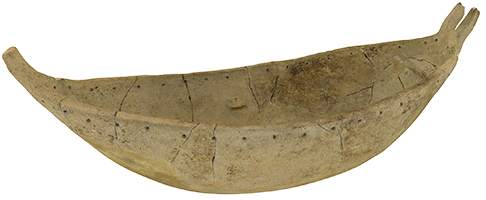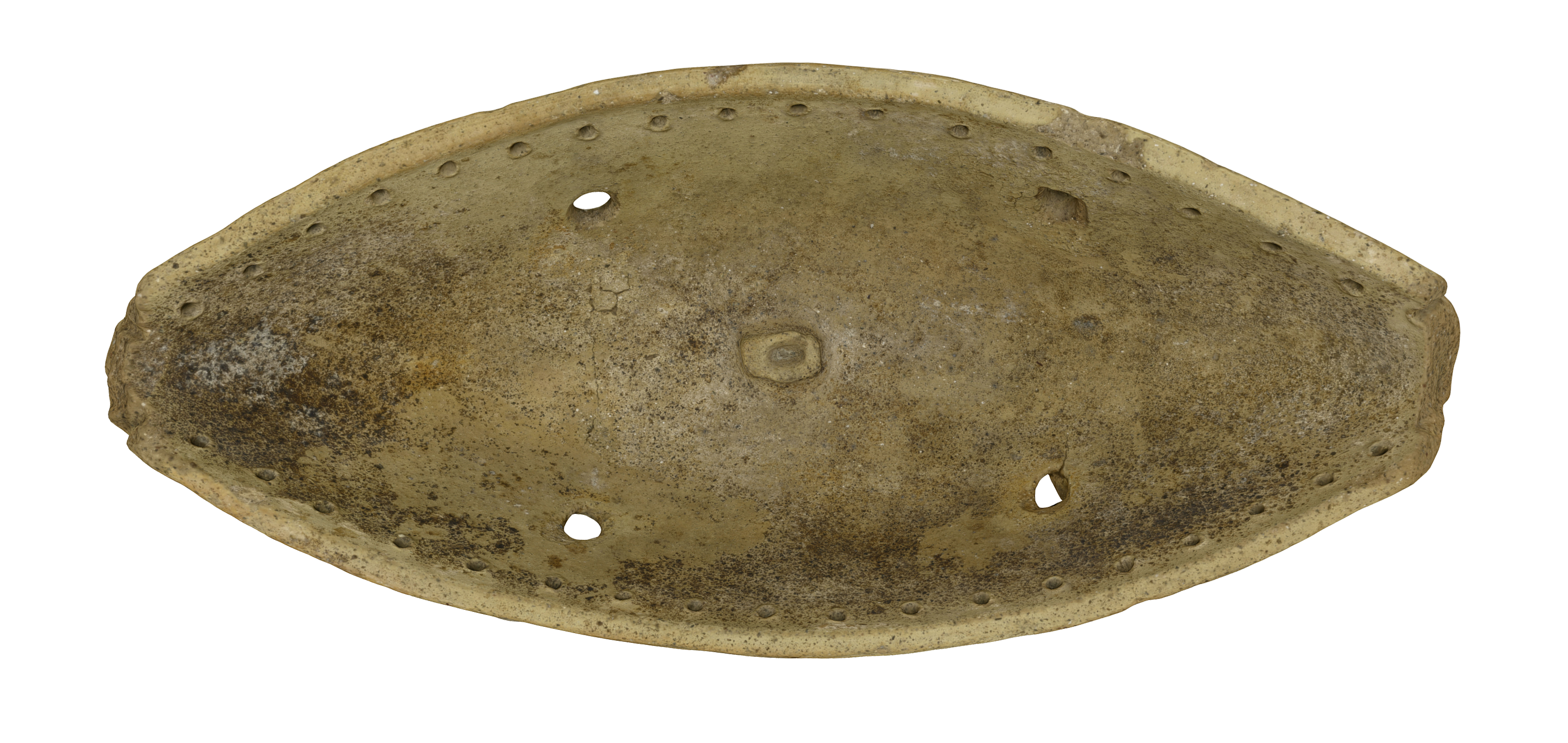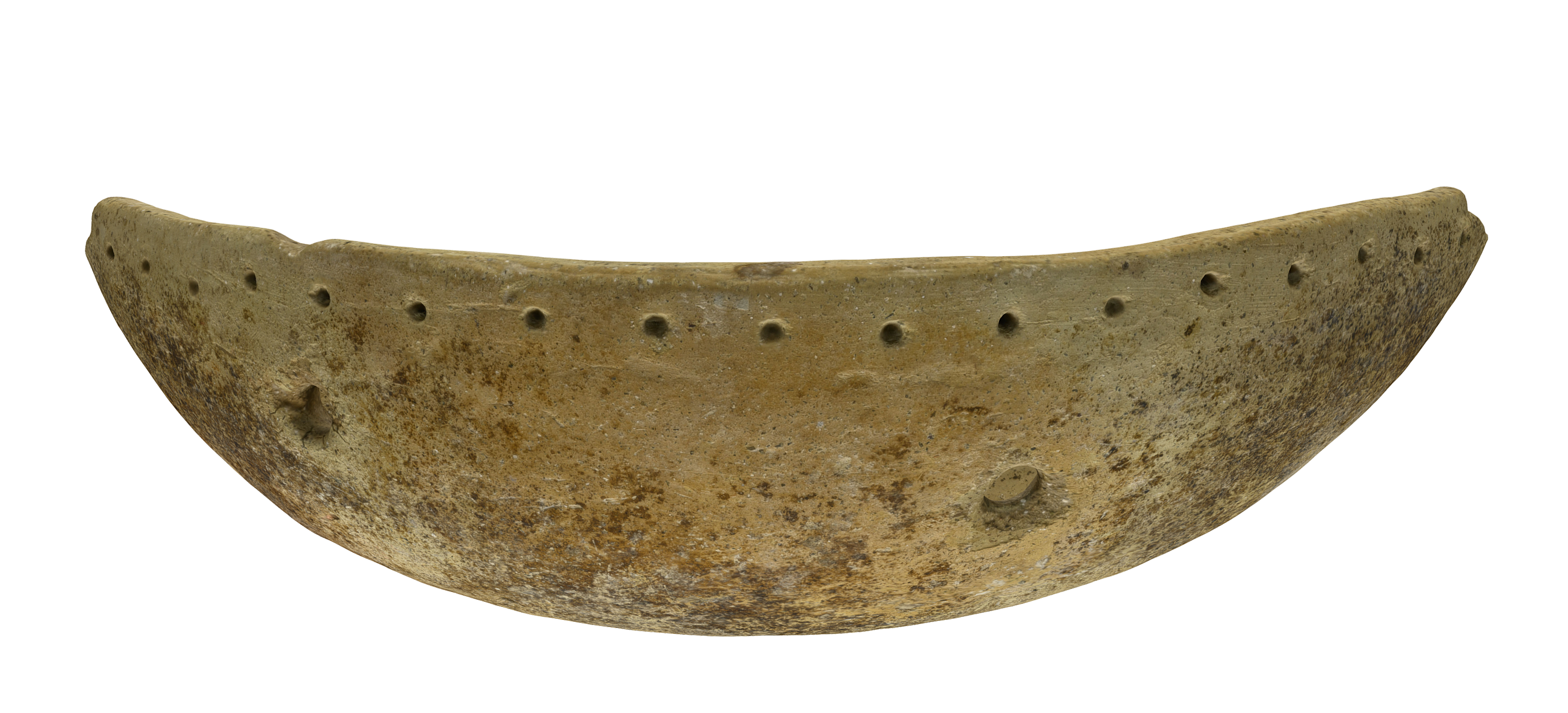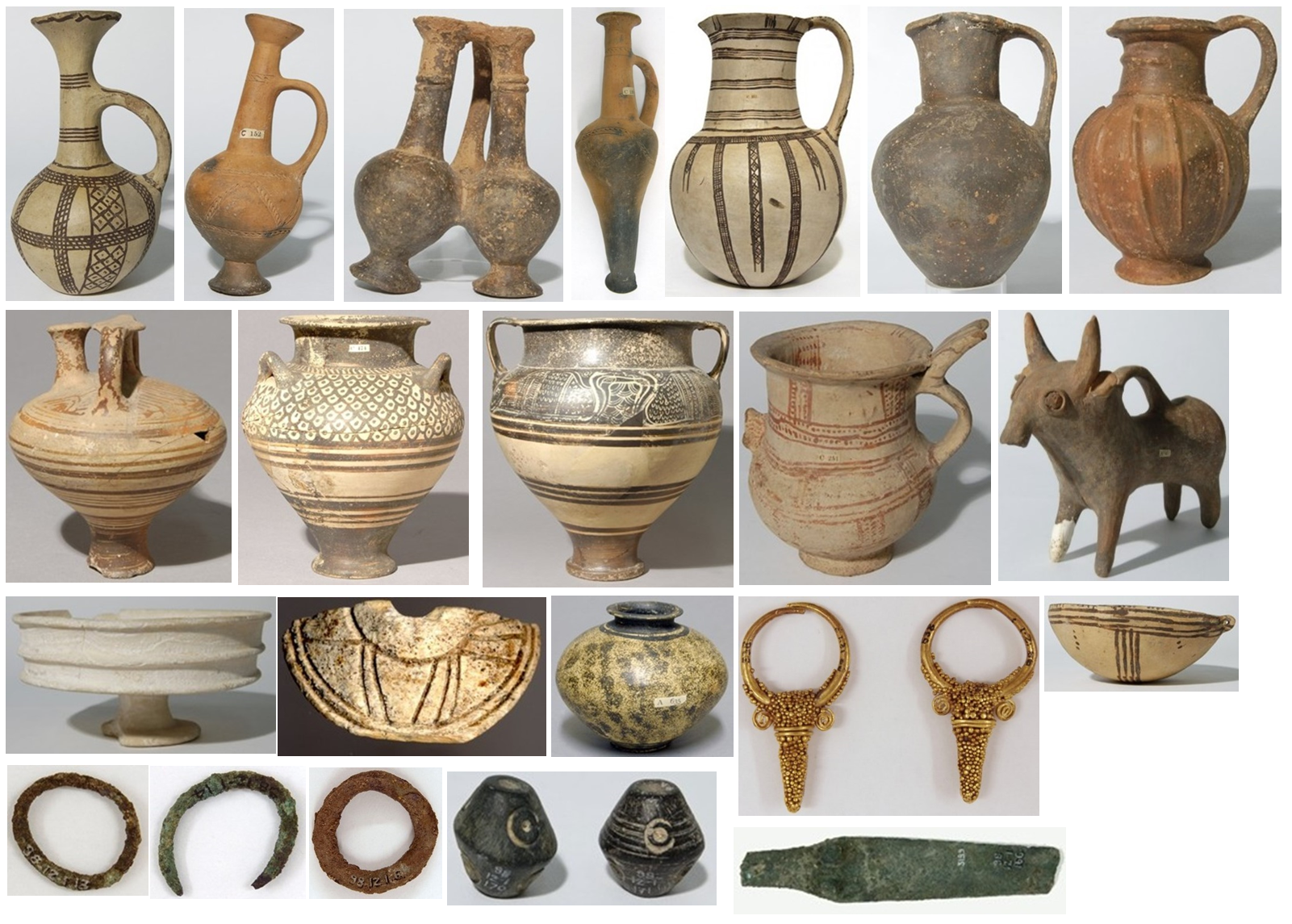Deep and beamy crescentic hull that is broad amidships, with a flat topped incurving sheer. The bottom is narrow and flattened. Both stems are damaged with their extremities missing. Just below the gunwale (c. 1 cm below) is a row of evenly spaced horizontal holes running from stem to stem on either side (18 on each side). These are of even size and were pierced prior to firing. There is a raised mast-socket amidships (2 x 1.5 cm), with an oval depression at the top. There are four roughly cut holes1 cm in diameter, located 3cm below gunwale and 10 cm from the stem fore and aft on either side of the ship. These were probably used for hanging the ship.
Ship model
C8
LC I/II (1650-1200 B.C.)
Maroni, Zarukas, Site A, tomb 1
L: 32 cm; H: (amidships): 10 cm; beam (amidships): 15 cm
terracotta model, Plain White handmade ware with faint traces of painted decoration
Åström and Åström 1972: 516, 585; Basch 1987: 73, no. 143-44; Carbillet 2011: 227-229, fig. 6; Dolan 2023: 326-328, no. 7; Forsdyke 1911: 112; Göttlicher 1978: 34, no. 146, pl. 9; Gray 1974: G 20, 47, pl. G. II a; Johnson 1980: 15, no. 15, pl. IX; Knapp 2019: 142, no. 3, fig. 37b; Manning et al 2002: 109-11, fig. 3 (bottom) + n. 37; Merrillees 1974: 188, Pl. XXXVII-2 (left); Ohnefalsch-Richter 1893: Pl. 168 Ic; Wachsmann 1998: 64, 66, figs. 4.8, 4.9; Walters 1903: 6, no. A 49; Westerberg 1983: 12, 81, no. 6, fig. 6
Site: The tomb was excavated by a British Museum team in 1897. Walters lists 26 tombs for Site A (Maroni Tsaroukkas) although he reports that many other tombs were opened but were deemed uninteresting due to the fact they contained predominantly local wares. A re-examination of the site during the 1990s shows that the records of the early excavations were not comprehensive, with many objects considered not worthy of mention and preservation. The most notable omissions are skeletal remains, information on tomb size and architecture, as well as locally made pottery. Some 500 m from Tsaroukkas, the site of Maroni-Vournes boasted an ashlar built complex (late 14th-13th centuries B.C.) that was used for a mixture of storage and manufacturing with administrative as well as possibly ceremonial functions. Adjacent to it was a building that served as a large storage magazine, while traces of a similar ashlar building was located at Aspres further to the west. This indicates a large-scale centralized control of agricultural products in the Maroni area.
In addition, an underwater survey revealed a likely sheltered anchorage or inlet immediately off the coast of Tsatoukkas. The cultural remains recovered there date predominantly to the LBA, and include over 45 stone anchors (both one holed and three holed composite type) as well as an important ceramic assemblage that included at least 6 Canaanite jars (late MBA) and late MC/LC sherds. Additional imported pottery from the buildings at the coastal site includes a few Minoan pithoid jars, Egyptian amphorae, and large quantities of Canaanite jars. Luxury items were also noted, such as a glass kohl bottle, an LC seal and a faience scarab. The importance of the cemetery itself, located on a low cliff overlooking the key liminal area of the seashore and anchorage, is indicated by the abundance of imported goods of both Mycenaean and Eastern origin. The overall chronological span appears to be from the 15th to the 13th century. Walters' listing of only 26 tombs that contained imports and valuable objects points towards the existence of an elite group engaged in overseas trade, showcasing these contacts both through imports and imitations. The considerable body of Mycenaean imports ranges in date from LH II A to LH III B, with most being LH III A. Overall, the assemblage is typical of 14th century imports found at sites throughout Cyprus. The most common shape is the amphoroid krater (some with decorated chariot scenes). The overwhelming majority of this assemblage comes from tomb contexts. These were complemented by LC finewares restricted to shaped associated with drinking.
Tomb 1: Tomb of the usual BA type, c. 10 feet down, full of earth and contained an enormous amount of pottery (largely fragmentary). Most of the material found in the tomb is of LC I/II date. A total of 32 objects were recorded, including local and Mycenaean wares, stone, faience, bronze, gold, ivory, a bull figurine and a boat model. The tomb was plundered in antiquity, with further material discarded by the excavators. The international connections are highlighted by Mycenaean and Egyptian imports, while the commercial aspect is suggested by the bronze pan scale, stone weights, and boat model. According to the excavators, the boat model was discovered full of knucklebones.
The model represents an indigenous Cypriot vessel type.
Åström, L. and P. Åström. 1972. The Swedish Cyprus Expedition Vol. IV: 1D: The Late Cypriot Bronze Age. Other Arts and Crafts. Lund: Swedish Cyprus Expedition.
Basch, L. 1987. Le musée imaginaire de la marine antique. Athens: Institut Hellénique pour la preservation de la tradition nautique.
Carbillet, A. 2011. “Naviguer vers l’éternité. Les modèles de bateau en terre cuite chypriotes et leur association à la navigation eschatologique,” CCEC 41: 223-238.
Dolan, M. 2023. Ceci n'est pas un bateau: Reassessing terracotta boat models in Late Bronze and Iron Age Cyprus. University of Southhampton. Unpublished DPhil Thesis.
Forsdyke, E.J. 1911. "Minoan Pottery from Cyprus and the Origin of the Mycenaean Style," Journal of Hellenic Studies 31: 112.
Göttlicher, A. 1978. Materialien für ein Korpus der Schiffsmodelle im Altertum. Mainz: Philipp von Zabern.
Gray, D. 1974, Seewesen. Göttingen: Vandenhoeck und Ruprecht.
Johnson, J. 1980. Maroni de Chypre. Göteborg: P. Åström.
Knapp, A. B. 2018. Seafaring and Seafarers in the Bronze Age Eastern Mediterranean. Leiden: Sidestone Press.
Manning, S. W., D.A. Sewell and E. Herscher. 2002. “Late Cypriot IA Maritime Trade in Action: Underwater Survey at Maroni Tsaroukkas and the Contemporary East Mediterranean Trading System,” The Annual of the British School at Athens 97: 97-162.
Merrillees, R.S. 1974. Trade and transcendence in the Bronze Age Levant. SIMA XXXIX. Gothenburg.
Ohnefalsch-Richter, M. 1893. Kypros, die Bibel und Homer. Berlin.
Wachsmann, S. 1998. Seagoing Ships & Seamanship in the Bronze Age Levant. College Station, TX: Texas A&M University Press.
Walters, H.B. 1903. Catalogue of the Terracottas in the Department of Greek and Roman Antiquities, British Museum. London: Order of the Trustees.
Westerberg, K. 1983. Cypriote Ships from the Bronze Age to c. 500 B.C. (SIMA, Pocket-books, 22). Göteborg: P. Åströms förlag.











